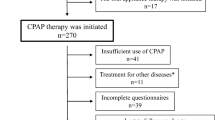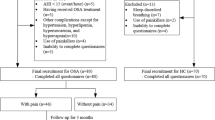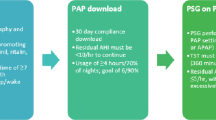Abstract
Purpose
To examine whether in obstructive sleep apnea (OSA) patients the degree of sleepiness, slow-wave sleep (SWS) loss, and hypoxia influence the response of psychological symptoms to continuous positive airway pressure (CPAP) therapy.
Methods
A prospectively planned cohort was assessed. Participants underwent full overnight polysomnography. All answered the Symptom Checklist-90-Revised (SCL-90) and the Epworth sleepiness scale (ESS). Only cases with an apnea-hypopnea index ≤60 events/h were 24 invited to participate. In an interview by telephone, after a follow-up period between 2 months and 1 year, patients informed whether they were in treatment with CPAP or remained voluntarily untreated. Subjects who accepted to participate answered for the second time the SCL-90 and the ESS. The baseline variables of interest were: (a) score of the ESS, (b) duration of SWS, and (c) time with arterial oxygen saturation below 90 %. The outcomes were the change in SCL-90 scores in all dimensions and indices of the questionnaire.
Results
A number of 73 patients, mostly men, were included. In uncontrolled analyses, CPAP-treated patients showed significant improvement at follow-up in 10 of the 13 SCL-90 scores. Comparing with the control group, only six scores were improved. Baseline sleepiness was the best predictor of SCL-90 improvement after CPAP treatment in the univariate analyses, and the only significant predictor of improvement in a multivariate regression model.
Conclusions
Sleepiness may supersede other factors that influence psychological improvement in CPAP-treated patients with severe OSA.


Similar content being viewed by others
References
DeZee KJ, Hatzigeorgiou C, Kristo D, Jackson JL (2005) Prevalence of and screening for mental disorders in a sleep clinic. J Clin Sleep Med 1:136–142
Tufik S, Santos-Silva R, Taddei JA, Bittencourt LR (2010) Obstructive sleep apnea syndrome in the Sao Paulo epidemiologic sleep study. Sleep Med 11:441–446
Dempsey JA, Veasey SC, Morgan BJ, O'Donnell CP (2010) Pathophysiology of sleep apnea. Physiol Rev 90:797–798
Beebe DW, Groesz L, Wells C, Nichols A, McGee K (2003) The neuropsychological effects of obstructive sleep apnea: a meta-analysis of norm-referenced and case-controlled data. Sleep 26:298–307
Sateia MJ (2003) Neuropsychological impairment and quality of life in obstructive sleep apnea. Clin Chest Med 24(2):249–259
Sánchez AI, Martínez P, Miró E, Bardwell WA, Buela-Casal G (2009) CPAP and behavioral therapies in patients with obstructive sleep apnea: effects on daytime sleepiness, mood, and cognitive function. Sleep Med Rev 13:223–233
Saunamäki T, Himanen SL, Polo O, Jehkonen M (2010) Executive dysfunction and learning effect after continuous positive airway pressure treatment in patients with obstructive sleep apnea syndrome. Eur Neurol 63:215–220
Derogatis LR, Rickels K, Rock AF (1976) The SCL-90 and the MMPI: a step in the validation of a new self-report scale. Br J Psychiatry 128:280–289
Yue W, Hao W, Liu P, Liu T, Ni M, Guo Q (2003) A case–control study on psychological symptoms in sleep apnea–hypopnea syndrome. Can J Psychiatry 48:318–323
Giles TL, Lasserson TJ, Smith B, White J, Wright JJ, Cates CJ (2006) Continuous positive airways pressure for obstructive sleep apnoea in adults. Cochrane Database Syst Rev 3, CD001106
Tomfohr LM, Ancoli-Israel S, Loredo JS, Dimsdale JE (2011) Effects of continuous positive airway pressure on fatigue and sleepiness in patients with obstructive sleep apnea: data from a randomized controlled trial. Sleep 34:121–126
Diamanti C, Manali E, Ginieri-Coccossis M, Vougas K, Cholidou K, Markozannes E, Bakakos P, Liappas I, Alchanatis M (2013) Depression, physical activity, energy consumption, and quality of life in OSA patients before and after CPAP treatment. Sleep Breath. doi:10.1007/s11325-013-0815-6
Sánchez AI, Buela-Casal G, Bermúdez MP, Casa-Maldonado F (2001) The effects of continuous positive air pressure treatment on anxiety and depression levels in apnea patients. Psychiatry Clin Neurosci 55:641–646
Kingshott RN, Vennelle M, Hoy CJ, Engleman HM, Deary IJ, Douglas NJ (2000) Predictors of improvements in function outcomes with CPAP therapy. Am J Respir Crit Care Med 161(3 Pt 1):866–871
Barnes M, McEvoy RD, Banks S, Tarquinio N, Murray CG, Vowles N, Pierce RJ (2004) Efficacy of positive airway pressure and oral appliance in mild to moderate obstructive sleep apnea. Am J Respir Crit Care Med 170:656–664
Haensel A, Norman D, Natarajan L, Bardwell WA, Ancoli-Israel S, Dimsdale JE (2007) Effect of a 2 week CPAP treatment on mood states in patients with obstructive sleep apnea: a double-blind trial. Sleep Breath 11:239–244
Marshall NS, Neill AM, Campbell AJ, Sheppard DS (2005) Randomised controlled crossover trial of humidified continuous positive airway pressure in mild obstructive sleep apnoea. Thorax 60:427–432
Lee IS, Bardwell W, Ancoli-Israel S, Loredo JS, Dimsdale JE (2012) Effect of three weeks of continuous positive airway pressure treatment on mood in patients with obstructive sleep apnoea: a randomized placebo-controlled study. Sleep Med 13:161–166
Barnes M, Houston D, Worsnop CJ, Neill AM, Mykytyn IJ, Kay A, Trinder J, Saunders NA, Douglas McEvoy R, Pierce RJ (2002) A randomized controlled trial of continuous positive airway pressure in mild obstructive sleep apnea. Am J Respir Crit Care Med 165:773–780
Engleman HM, Martin SE, Kingshott RN, Mackay TW, Deary IJ, Douglas NJ (1998) Randomised placebo controlled trial of daytime function after continuous positive airway pressure (CPAP) therapy for the sleep apnoea/hypopnoea syndrome. Thorax 53:341–345
Muñoz A, Mayoralas LR, Barbé F, Pericás J, Agustí AGN (2000) Long-term effects of CPAP on daytime functioning in patients with sleep apnoea syndrome. Eur Respir J 15:676–681
Engleman HM, Martin SE, Deary IJ, Douglas NJ (1997) Effect of CPAP therapy on daytime function in patients with mild sleep apnoea/hypopnoea syndrome. Thorax 52:114–119
Derderian SS, Bridenbaugh RH, Rajagopal KR (1988) Neuropsychologic symptoms in obstructive sleep apnea improve after treatment with nasal continuous positive airway pressure. Chest 94:1023–1027
Yu BH, Ancoli-Israel S, Dimsdale JE (1999) Effect of CPAP treatment on mood states in patients with sleep apnea. J Psychiatr Res 33:427–432
Bardwell WA, Berry CC, Ancoli-Israel S, Dimsdale JE (1999) Psychological correlates of sleep apnea. J Psychosom Res 47:583–596
Bardwell WA, Norman D, Ancoli-Israel S, Loredo JS, Lowery A, Lim W, Dimsdale JE (2007) Effects of 2-week nocturnal oxygen supplementation and continuous positive airway pressure treatment on psychological symptoms in patients with obstructive sleep apnea: a randomized placebo-controlled study. Behav Sleep Med 5:21–38
Martinez D, Breitenbach TC, Lumertz MS, Alcântara DL, da Rocha NS, Cassol CM, Lenz Mdo C (2011) Repeating administration of Epworth sleepiness scale is clinically useful. Sleep Breath 15:763–773
Martin LG, Freedman VA, Schoeni RF, Andreski PM (2010) Trends in disability and related chronic conditions among people ages fifty to sixty-four. Health Aff (Millwood) 29:725–731
Martinez D, Basile BR (2005) Sibutramine does not worsen sleep apnea syndrome: a randomized double-blind placebo-controlled study. Sleep Med 6(5):467–470
Lenz MC, Martinez D (2007) Awakenings change results of nighttime ambulatory blood pressure monitoring. Blood Press Monit 12:9–15
Iber C, Ancoli-Israel S, Chesson A, Quan SF (2007) for the American Academy of Sleep Medicine. The AASM Manual for the scoring of sleep and associated events: rules, terminology and technical specifications. American Academy of Sleep Medicine, Westchester
Derogatis LR (1994) Symptom Checklist-90-R (SCL-90-R) Administration, scoring, and procedures manual, 3rd edn. National Computer Systems, Mineapolis
Derogatis LR, Lipman RS, Covi L (1973) SCL-90: an outpatient psychiatric rating scale-preliminary report. Psychopharmacol Bull 9:13–28
American Educational Research Association, American Psychological Association, & National Council on Measurement in Education (1999) Standards for educational and psychological testing. American Educational Research Association, Washington, DC
Krieger J, Kurtz D, Petiau C, Sforza E, Trautmann D (1996) Long-term compliance with CPAP therapy in obstructive sleep apnea patients and in snorers. Sleep 19:S136–S143
McArdle N, Devereux G, Heidarnejad H, Engleman HM, Mackay TW, Douglas NJ (1999) Long-term use of CPAP therapy for sleep apnea/hypopnea syndrome. Am J Respir Crit Care Med 159(4 Pt 1):1108–1114
Hrubos-Strøm H, Einvik G, Nordhus IH, Randby A, Pallesen S, Moum T, Omland T, Dammen T (2012) Sleep apnoea, anxiety, depression and somatoform pain: a community-based high-risk sample. Eur Respir J 40:400–407
Pillar G, Lavie P (1998) Psychiatric symptoms in sleep apnea syndrome: effects of gender and respiratory disturbance index. Chest 114:697–703
Van Der Kloet D, Giesbrecht T, Franck E, Van Gastel A, De Volder I, Van Den Eede F, Verschuere B, Merckelbach H (2013) Dissociative symptoms and sleep parameters—an all-night polysomnography study in patients with insomnia. Compr Psychiatry 54(6):658–664
Acknowledgments
This study was partly supported by Fundo de Incentivo à Pesquisa (FIPE), HosPital de Clínicas de Porto Alegre (HCPA, Brazil). Ms. Carissimi was the recipient of a grant provided by the Brazilian government agency Coordenação de Aperfeiçoamento de Pessoal de Nível Superior (CAPES). Ms. Fiori was the recipient of a grant provided by the Brazilian government agency National Counsel of Technological and Scientific Development (CNPq).
Conflicts of interest
Authors have reported no financial conflicts of interest regarding the subject of the present study. Dr. Martinez is the co-owner of a sleep medicine clinic.
Financial support
This study was partly supported by Fundo de Incentivo à Pesquisa (FIPE), Hospital de Clínicas de Porto Alegre (HCPA, Brazil).
Author information
Authors and Affiliations
Corresponding author
Rights and permissions
About this article
Cite this article
Carissimi, A., Martinez, D., Kim, L.J. et al. Factors influencing the response of psychological symptoms to continuous positive airway pressure therapy. Sleep Breath 18, 499–507 (2014). https://doi.org/10.1007/s11325-013-0911-7
Received:
Revised:
Accepted:
Published:
Issue Date:
DOI: https://doi.org/10.1007/s11325-013-0911-7




